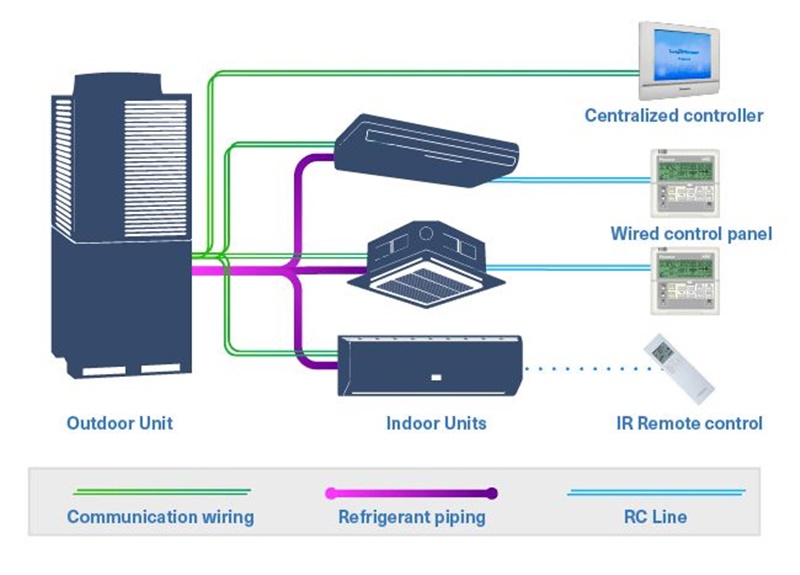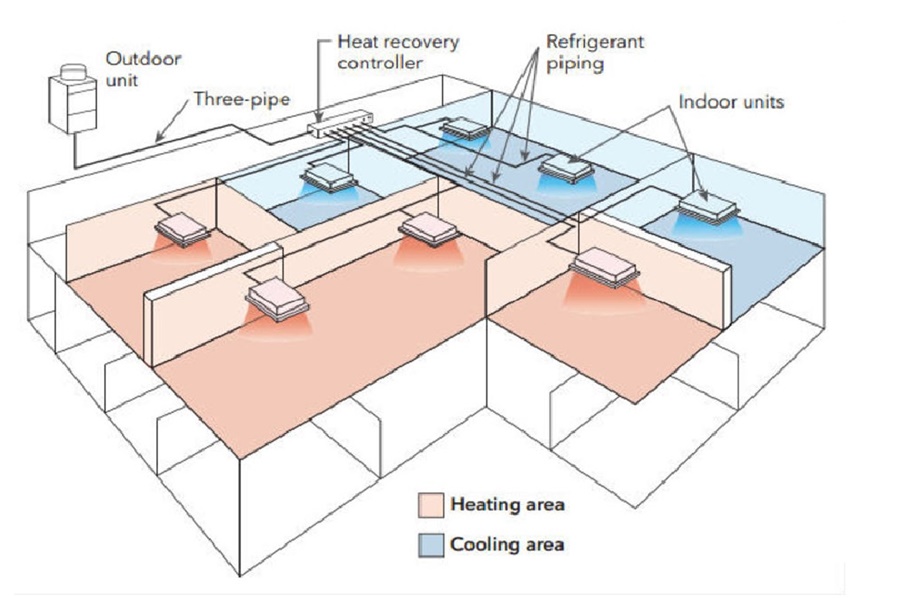In the rapidly evolving field of HVAC (Heating, Ventilation, and Air Conditioning), the demand for more energy-efficient, flexible, and cost-effective solutions has led to the rise of VRF HVAC systems. But what exactly is a VRF HVAC system, and how does it compare to traditional air conditioning systems? In this article, we will explore the key features, advantages, and applications of Variable Refrigerant Flow (VRF) systems, helping you understand why this technology is becoming increasingly popular for both residential and commercial buildings.

Understanding VRF HVAC Systems
A Variable Refrigerant Flow (VRF) system is an advanced heating and cooling solution that utilizes refrigerant as the cooling and heating medium. This system is highly versatile, offering precise control over the temperature in different areas of a building. VRF systems can simultaneously heat one part of the building while cooling another, making them ideal for buildings with varying thermal demands.
The VRF system is comprised of an outdoor unit, multiple indoor units, and a network of refrigerant piping. The outdoor unit adjusts the amount of refrigerant flowing through the system based on demand. This ability to modulate refrigerant flow makes VRF systems more energy-efficient than traditional HVAC systems, such as those using fixed-speed compressors.
Key Components of a VRF HVAC System
1. Outdoor Units: These are typically large condensers or heat pump systems that regulate refrigerant flow to the indoor units.
2. Indoor Units: These can vary in size and type, including wall-mounted units, ceiling cassettes, and floor-standing units. The indoor units are designed to suit the aesthetic and functional needs of the building.
3. Refrigerant Piping: The refrigerant circulates between the outdoor and indoor units through insulated piping, ensuring efficient heat exchange.
4. Controller: The system uses advanced control systems to regulate the refrigerant flow, temperature, and operation mode, ensuring optimized comfort.
Advantages of VRF HVAC Systems
When it comes to energy efficiency and environmental impact, VRF HVAC systems offer several notable advantages over traditional systems. These benefits are particularly relevant for those seeking long-term, sustainable solutions for both residential and commercial spaces.
1. Energy Efficiency
One of the primary advantages of VRF HVAC systems is their exceptional energy efficiency. Unlike traditional systems that often operate at full capacity, VRF systems adjust refrigerant flow to match the specific heating or cooling demand of each zone. This dynamic operation ensures that the system only uses energy when needed, reducing waste and lowering overall energy consumption.
2. Flexibility and Zoning
VRF systems provide precise control over multiple zones within a building, allowing different areas to be heated or cooled independently. This zoning capability means that occupants in various rooms or areas can enjoy tailored comfort without affecting the rest of the building. For example, you can have one area cooled while another is heated. This feature is particularly valuable in large commercial spaces, such as office buildings, where different departments or rooms may have different temperature requirements.
3. Quiet Operation
Traditional HVAC systems can often be noisy due to the large fans and compressors that work at full speed. In contrast, VRF systems are designed to operate quietly, as they adjust their output based on demand. The variable-speed compressors allow for smoother operation, which is especially beneficial in noise-sensitive environments like hotels, hospitals, or residential properties.
4. Space-Saving Design
VRF systems are also known for their compact design. With fewer bulky components, they require less space compared to conventional HVAC systems. The smaller, more adaptable indoor units can be mounted discreetly, either in the ceiling, on the wall, or even integrated into furniture, making them ideal for buildings with limited space.
5. Reduced Maintenance Costs
Because of their highly efficient, modular nature, VRF systems tend to require less maintenance compared to traditional HVAC systems. The advanced controls and components are designed to last longer and require fewer repairs. Additionally, since VRF systems operate only when necessary, the wear and tear on parts are significantly reduced.
How VRF HVAC Systems Work
A VRF system works by using inverter-driven compressors that vary the refrigerant flow based on real-time demand. Here’s how the system operates:
1. Heat Transfer: The outdoor unit absorbs heat from the outside air (in the case of cooling) or expels heat (in the case of heating).
2. Variable Refrigerant Flow: The inverter-controlled compressor adjusts the flow of refrigerant to the indoor units. When cooling or heating needs are higher, the compressor will increase refrigerant flow. Conversely, if the demand is lower, the compressor reduces the flow, saving energy.
3. Simultaneous Heating and Cooling: In more advanced VRF systems, it’s possible to have heating in one zone while cooling another, making them highly effective for complex environments, such as multi-story buildings with differing temperature needs.
4. Energy Recovery: Some VRF systems include heat recovery technology, which allows the system to recover heat from areas being cooled and transfer it to areas that require heating. This further improves energy efficiency by minimizing wasted energy.
Applications of VRF HVAC Systems
Given their versatility and energy-saving capabilities, VRF HVAC systems are widely used in both residential and commercial buildings. Here’s a closer look at some common applications:
1. Residential Buildings
In residential settings, VRF systems are particularly well-suited for homes that have multiple floors or large open spaces. The zoning capability ensures that each room can be controlled independently, allowing for personalized comfort. Additionally, their quiet operation and sleek design make them ideal for high-end homes or apartments.
2. Commercial Buildings
For large commercial spaces, such as office buildings, shopping centers, and hotels, VRF systems offer unmatched flexibility and efficiency. The ability to control multiple zones individually, combined with their ability to work with existing infrastructure, makes them an attractive choice for businesses looking to optimize energy usage while maintaining a comfortable environment for employees and customers.
3. Healthcare Facilities
In healthcare facilities, where temperature control is critical, VRF systems provide reliable heating and cooling solutions without disrupting patient care. Their quiet operation ensures a peaceful environment for recovery, while the zoning capabilities allow specific areas to be regulated independently, ensuring the comfort of both patients and medical staff.
4. Educational Institutions
Schools, universities, and other educational facilities benefit from VRF systems due to their efficiency and versatility. Different rooms and sections of the building can be heated or cooled to specific requirements, ensuring optimal learning environments throughout the day.
Conclusion
The adoption of VRF HVAC systems is rapidly growing due to their energy efficiency, flexibility, and ability to provide precise control over building temperature. Whether for residential, commercial, or industrial use, VRF technology is a future-proof solution for climate control, offering both environmental and economic benefits.
